When it comes to creating a healthier, more stylish kitchen, ceramic kitchenware has become a top choice for American households. From nonstick pots and pans to versatile baking dishes and sleek dinnerware sets, ceramic kitchenware blends modern performance with timeless beauty. Unlike traditional nonstick cookware that often relies on chemicals like PTFE or PFOA, ceramic surfaces offer a naturally slick coating made from sand-derived materials, making them both eco-friendly and safer for everyday cooking.
But ceramic kitchenware isn’t just about being “green” — it’s also about performance and design. These pieces heat evenly, resist scratches, and bring a touch of elegance straight from the oven to the table. Whether you’re whipping up a quick stir-fry, slow-roasting veggies, or serving a family meal, ceramic cookware and bakeware offer durability and versatility. Plus, the growing variety of colors and styles means they’re just as beautiful as they are functional.
With so many brands and styles on the market, the challenge isn’t deciding if you should buy ceramic kitchenware, but which ones are truly worth the investment. That’s why we’ve put together this guide to help you understand what to look for before adding ceramic pieces to your kitchen.
Buying Guide: How to Choose the Best Ceramic Kitchenware
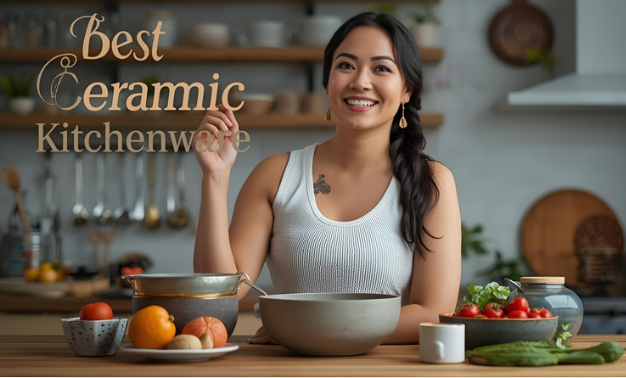
1. Type of Kitchenware You Need
Ceramic kitchenware comes in many forms — frying pans, saucepans, Dutch ovens, baking dishes, and dinnerware. Start by identifying your cooking style. Do you need an everyday nonstick pan for eggs and pancakes, or are you looking for bakeware that goes straight from oven to table? Matching the type of ceramic item to your needs ensures you get the most use out of it.
2. Material Quality
Not all ceramics are created equal. Look for kitchenware made from high-quality ceramic coatings over aluminum or stainless steel for cookware, or durable stoneware/porcelain ceramic for bakeware and dinnerware. High-quality ceramics won’t chip or wear down quickly, and they distribute heat evenly for better cooking results.
3. Nonstick Performance & Safety
One of ceramic’s biggest appeals is its nonstick surface. Check if the product is PTFE, PFOA, lead, and cadmium free. This ensures safer cooking, especially at high heat. A good ceramic pan should let you cook with less oil and clean up easily without scrubbing.
4. Heat Tolerance & Compatibility
Pay attention to the maximum heat rating. Some ceramic cookware is oven-safe up to 500°F, while others cap out around 350°F. If you love stovetop-to-oven recipes, higher tolerance is key. Also, confirm if the piece is induction compatible (not all ceramic cookware is).
5. Durability & Scratch Resistance
Fine hairline scratches or chips can shorten the life of ceramic kitchenware. Choose pieces with reinforced ceramic coatings or multi-layer designs for durability. For bakeware and dinnerware, opt for brands known for chip-resistant finishes.
6. Ease of Maintenance
Ceramic should be low-maintenance, but not all products are dishwasher-safe. If easy cleanup matters, look for dishwasher-friendly ceramic. For cookware, check if the nonstick surface maintains performance even after multiple washes.
7. Design & Aesthetic Appeal
One major advantage of ceramic kitchenware is its design variety. From glossy white dinnerware to pastel-colored Dutch ovens, ceramic pieces double as tableware. Pick styles that complement your kitchen aesthetic if you want them to shine on both stovetop and dining table.
8. Budget & Brand Reputation
Ceramic kitchenware ranges from affordable starter sets to premium, long-lasting investments. Well-known brands often offer better warranties and customer support. Decide on a budget but prioritize value — sometimes paying a bit more upfront means years of reliable cooking.
👉 In short: the best ceramic kitchenware should combine safe materials, excellent nonstick performance, durability, and design that fits your lifestyle. Whether you’re upgrading your cookware, investing in oven-safe bakeware, or adding stylish ceramic plates to your dining collection, making informed choices ensures your kitchenware lasts for years.
1. Caraway Nonstick Ceramic Cookware Set
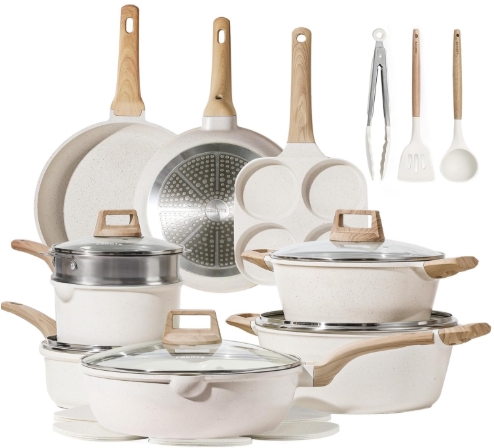
Product Description
The Caraway Nonstick Ceramic Cookware Set is a premium kitchen set known for its sleek design and strong performance. It comprises essentials like a frying pan, saucepan, Dutch oven, and sauté pan (with lids), plus storage accessories—lid rack and pan organizer. The interior has a ceramic nonstick coating that’s free from PTFE, PFOA, lead, and cadmium, which is marketed as a healthier alternative to traditional nonstick surfaces. The set is also oven-safe to high temperatures (up to ~550°F) and induction-compatible, making it versatile for different cooktops. Reviewers praise how evenly it heats, how food slides off, and its aesthetic appeal.
Key Features
- Ceramic, PTFE/PFOA-free nonstick interior coating.
- Oven safe up to high temperatures (~550°F).
- Induction-compatible design.
- Comes with storage accessories: rack & lid organizer.
- Elegant color options and modern design.
Pros
- Excellent nonstick performance; very little food residue.
- Heats evenly, minimal hot spots.
- Stylish design—looks good in modern kitchens.
- Good value over time if cared for (long lifespan with proper use).
Cons
- Higher upfront cost compared to budget ceramic sets.
- Handles and lids may require care (e.g., handle gets hot, lids have temperature limits).
- Requires hand washing ideally; some cautions about dishwasher degrading coating.
Recommendation
If you want a premium, durable, and stylish cookware set that you’ll use often—and are willing to pay for quality—the Caraway set is an excellent investment. Great if your kitchen gets a lot of use, and you care not just about cooking performance but also the look of your cookware.
2. GreenLife Stainless Pro Ceramic Cookware Set
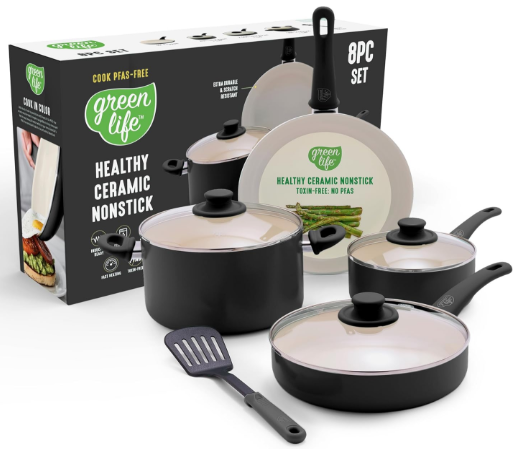
Product Description
The GreenLife Stainless Pro set is an affordable mid-range ceramic cookware set aimed at those wanting decent quality without breaking the bank. The set includes several pots and pans of differing sizes with glass lids, and its ceramic coating is reinforced for better durability. It also features a stainless steel or aluminum core designed to distribute heat widely. It’s often praised for good performance in common tasks (eggs, sauté, sauces) and is induction-compatible (at least some variants are).
Key Features
- Ceramic nonstick interior reinforced for durability.
- Multiple cookware sizes including frying pans, saucepans, and a stockpot.
- Compatible with induction cooktops in certain models.
- Oven safe up to moderate-high temperatures.
Pros
- Better price point for solid everyday use.
- Lightweight and easy to handle.
- Food tends not to stick significantly; cleanup is easier.
- Good range of sizes in one set.
Cons
- Handles may get hot.
- Coating may wear sooner under heavy, frequent use.
- Some pieces may not be oven safe to very high temperatures; always check for specific models.
Recommendation
Good pick if you want a balance between cost and quality. For families or users who cook frequently but don’t want to invest at the highest tier, GreenLife offers a reliable and usable ceramic set.
3. T-fal Initiatives Ceramic Cookware Set
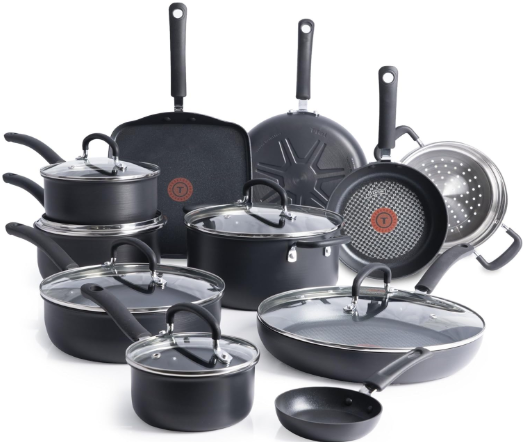
Product Description
The T-fal Initiatives Ceramic Cookware Set is commonly recommended as a budget option for those starting out or updating older nonstick pans. The set usually includes several pans, saucepans, lids, and possibly a griddle, depending on the version. It offers ceramic interior — white/bright color — which helps to see browning and food color. The set is praised for nonstick ease (especially for light cooking) and material safety.
Key Features
- White ceramic nonstick interior.
- Multiple piece set including various pan/saucepan sizes and lids.
- Aluminum base heats fairly quickly.
- Product often includes utensils/tools; handle designs stay cooler than basic models.
Pros
- Very reasonable price for a complete set.
- Good for lighter cooking (eggs, vegetables, low-to-medium heat).
- Relatively easy cleaning due to ceramic nonstick.
- Ideal for first-time buyers or those replacing older nonstick pans.
Cons
- Not always oven-safe to very high temperature.
- Ceramic coating may fade or degrade faster under frequent high-heat or metal utensils.
- Handles and lids may be less robust; lids sometimes limit oven temp.
- Some pans may heat unevenly if base is thin; need moderate heat, not high.
Recommendation
Ideal as a starter set for someone building kitchen cookware or for renters. If you’re cooking daily and doing a variety of high-heat tasks (searing, broiling), you may want to spend more.
4. Beautiful by Drew Barrymore 12-Piece Ceramic Nonstick Cookware Set
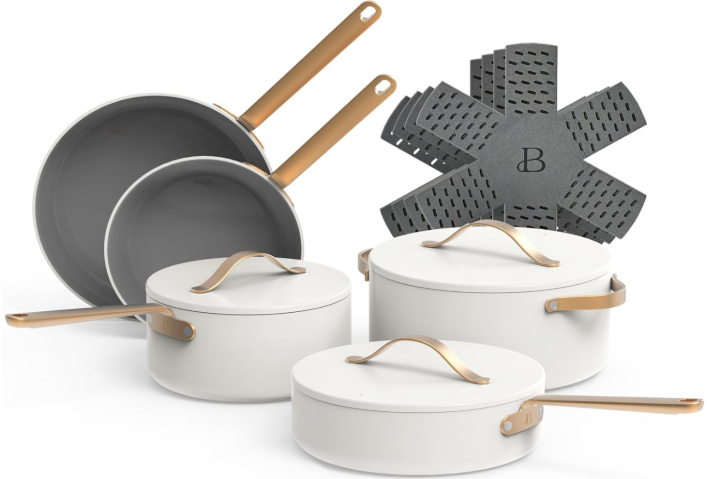
Product Description
This 12-piece set from the Beautiful by Drew Barrymore line offers both aesthetic appeal and functional performance. The set usually includes frying pans, saucepans with lids, a sauté pan or similar, and additional pieces like lid protectors. It features ceramic nonstick interior, stylish exterior finishes, and attention to design detail. According to reviews, this set holds heat well and cleans up nicely, though users note that care is required to maintain coating.
Key Features
- 12 pieces: multiple sizes of pans, saucepans, etc.
- Ceramic nonstick coating.
- Stylish color/finish and nesting/storage features to save space.
- Handles stay cool and lids are tempered glass in many versions.
Pros
- Large set gives flexibility for multiple cooking tasks.
- Looks good—color/finish is often a selling point.
- Good performance for typical home cooking: eggs, sauces, sauté, etc.
- Design and storage/accessory add-ons (lid protectors) improve usability.
Cons
- Larger size means more storage space required.
- Some pieces may be heavier; handling may be bulkier.
- Coating may degrade over time if used often over high heat.
- Some tools talk about color-fading or discoloration on exteriors under heavy use.
Recommendation
Good for someone who wants both function and style, perhaps furnishing a whole kitchen look. If you like matching finishes and want enough pieces for family meals, this set gives a lot. But if you use high-heat cooking a lot, watch the temp and use non-metal utensils.
5. GreenPan Rio Healthy Ceramic Nonstick Cookware Set
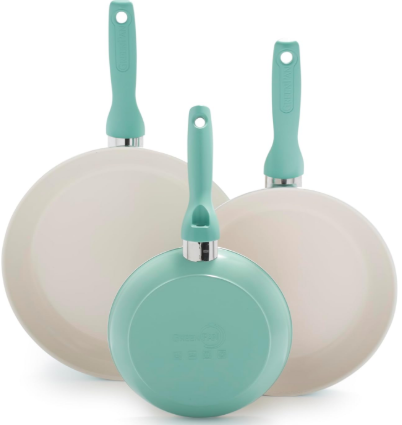
Product Description
The GreenPan Rio Healthy Ceramic Nonstick Cookware Set is reviewed as a “budget-friendly investment” with a large number of pieces (around 16 in many versions), covering several sizes of skillets, saucepans, stockpots, lids, possibly steamer insert, and utensils. GreenPan is known for using ceramic nonstick surfaces marketed as “healthier”, avoiding PTFE/PFOA. Testing reports say great nonstick performance (for eggs, etc.), but note that heating is responsive (heats fast) so some learning curve needed.
Key Features
- Large set (≈16 pieces) including several sizes of cookware and tools.
- Healthy ceramic nonstick interior.
- Decent oven safety (moderate), comfortable handles, tempered glass lids.
Pros
- Good value: many pieces gives you options.
- Nonstick works well for lighter cooking.
- Cleanup is generally easy.
- Variety of sizes/tools means less need to buy extras.
Cons
- Exterior or bottom surfaces may discolor after repeated use.
- Handles may get hot, especially with larger pots.
- Some pieces are bulky.
- Coating life may not be as long as premium brands under heavy, frequent use.
Recommendation
Strong choice if you want to equip your kitchen comprehensively without a huge outlay. Good for households cooking a variety of dishes. Just use medium or lower heat, non-metal utensils, and maybe avoid putting everything in the dishwasher to extend lifespan.
6. OXO Ceramic Professional Non-Stick Cookware Set
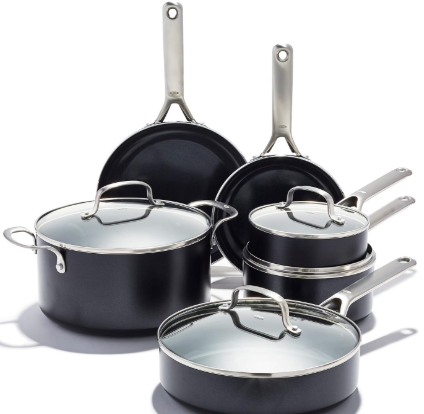
Product Description
The OXO Ceramic Professional Non-Stick Cookware Set is positioned toward more serious home cooks who want higher durability and performance from their ceramic tools. The set includes multiple pans, saucepans, sauté pan, and casserole or stockpot with glass lids. The ceramic-coated interiors are combined with better construction/heat distribution (often heavy-gauge aluminum or other materials), well-designed handles, and features like tempered glass lids and oven safety. According to reviews, this set does well with nonstick, doesn’t warp easily, and cleans up well.
Key Features
- Multiple cookware pieces: pans, saucepans, etc., with lids.
- Ceramic nonstick interior, advertised with durability.
- Better base material (aluminum, heavy gauge) to reduce hot spots.
- Oven safe to higher temperature (varies by model) and compatible with some cooktops, though induction may depend.
Pros
- More even heat distribution; fewer hotspots.
- Nonstick performance good; less sticking than very cheap ceramic sets.
- More durable build means it handles regular use better.
- Glass lids make monitoring cooking easier without lifting lids.
Cons
- Higher cost relative to simple ceramic cookware.
- Bigger and heavier set—more storage space required.
- As with all ceramic nonstick sets, over time coating may fade or lose slickness.
- Need to use care: non-metal utensils, lower-medium heat, careful cleaning; otherwise performance drops.
Recommendation
Great for someone who cooks often and wants something close to professional performance without going fully to high-end metals or cast iron. If you want a set that will hold up to daily cooking (stirs, sautés, simmering) and want nonstick convenience, this set is a strong contender.
If you like, I can build a comparison table of these six (price vs durability vs oven safety vs size pieces) to help you pick based on your priorities.
How to Use Ceramic Kitchenware Properly
Ceramic kitchenware is designed to make cooking easier, healthier, and more stylish, but like all cookware, it works best when you use it correctly. Here’s a simple step-by-step on how to get the most out of your ceramic pots, pans, and bakeware.
1. Season (Optional but Helpful)
Some ceramic cookware benefits from a light seasoning before first use. Wipe a thin layer of cooking oil over the surface, heat gently for a few minutes, then wipe clean. This helps extend nonstick life.
2. Preheat Gently
Ceramic pans don’t need high heat. Always start on low or medium heat and allow the cookware to warm gradually. Preheating too hot, too fast can stress the coating and shorten its lifespan.
3. Use the Right Utensils
Stick to wooden, silicone, or nylon utensils. Metal spoons, forks, or spatulas can scratch and damage the ceramic coating.
4. Cook with Less Oil
Ceramic is naturally nonstick, so you can cook with very little oil or butter. This is perfect for healthier cooking and helps prevent build-up on the surface.
5. Oven Use
Most ceramic kitchenware is oven-safe up to 350°F–550°F (depending on brand). Always check your manufacturer’s limit. Avoid sudden temperature changes, like taking a hot dish and placing it on a cold countertop—thermal shock can crack it.
6. Cleaning After Use
- Let cookware cool completely before washing. Plunging hot ceramic into cold water may cause warping or cracks.
- Wash with mild soap and a soft sponge. Avoid steel wool or harsh abrasives.
- While many sets are dishwasher-safe, handwashing extends their life.
Safety Guide for Ceramic Kitchenware
Cooking with ceramic is generally safer than using chemical-based nonstick coatings, but here are a few safety rules to follow:
✅ Do’s
- Do cook on low to medium heat. Ceramic performs best at moderate temperatures.
- Do lift cookware properly. Ceramic bakeware and pots can be heavy—always use oven mitts and both hands when lifting.
- Do use trivets or pads. Hot ceramic placed directly on stone or glass counters can crack the cookware or the counter.
- Do store with care. If stacking ceramic pots and pans, place a soft cloth or pad between them to avoid scratches.
- Do use heat protectants. Always grab handles with mitts—ceramic can retain heat for a long time after cooking.
❌ Don’ts
- Don’t overheat empty pans. Heating an empty ceramic pan on high heat can damage the coating.
- Don’t use metal utensils. They will scratch the surface and shorten nonstick life.
- Don’t use cooking sprays. They leave residue that builds up and is hard to remove. Use a drop of oil instead.
- Don’t expose to extreme temperature changes. Example: moving a hot dish straight into the fridge or freezer.
- Don’t slam or drop ceramic. While durable, ceramic can chip or crack under impact.
Frequently Asked Questions (FAQs) About Ceramic Kitchenware
1. Is ceramic kitchenware safe to cook with?
Yes. High-quality ceramic kitchenware is free from harmful chemicals like PTFE, PFOA, lead, and cadmium. It’s one of the safest nonstick options available and ideal for everyday cooking.
2. Can ceramic cookware go in the oven?
Most ceramic cookware and bakeware are oven-safe, but the temperature limit varies by brand (usually between 350°F and 550°F). Always check the manufacturer’s instructions before baking or broiling.
3. How long does ceramic kitchenware last?
With proper care, ceramic cookware can last 2–5 years, while ceramic bakeware and dinnerware often last much longer. Handwashing, avoiding high heat, and using gentle utensils extend their lifespan.
4. Does food stick to ceramic cookware over time?
Yes, if not maintained properly. Food buildup, overheating, or using cooking sprays can reduce nonstick performance. Regular cleaning and occasional light seasoning help maintain a slick surface.
5. Is ceramic better than stainless steel or cast iron?
It depends on your needs. Ceramic is lighter, nonstick, and easier to clean, while stainless steel and cast iron offer unmatched durability and higher heat performance. Many cooks use a mix of all three for flexibility.
6. Are ceramic pans dishwasher safe?
Some are, but frequent dishwasher use may shorten the nonstick coating’s life. Handwashing with mild soap and a soft sponge is recommended.
7. Can ceramic cookware be used on induction stovetops?
Not all ceramic cookware is induction-compatible. If you have an induction cooktop, check for a magnetic stainless steel base before buying.
Conclusion
Ceramic kitchenware has quickly become a favorite among home cooks and health-conscious households across the U.S. Thanks to its non-toxic, eco-friendly design, sleek aesthetics, and naturally nonstick performance, it strikes the perfect balance between safety and style. From frying pans that make breakfast cleanup a breeze to oven-to-table bakeware that doubles as décor, ceramic pieces elevate both cooking and serving.
When shopping for the best ceramic kitchenware, focus on material quality, durability, heat resistance, and brand reputation. With proper care and mindful use, your investment will reward you with years of healthier, hassle-free meals.
If you’re looking to update your kitchen with cookware that is beautiful, functional, and safe, ceramic kitchenware is absolutely worth considering. It’s not just a cooking upgrade—it’s a lifestyle upgrade.